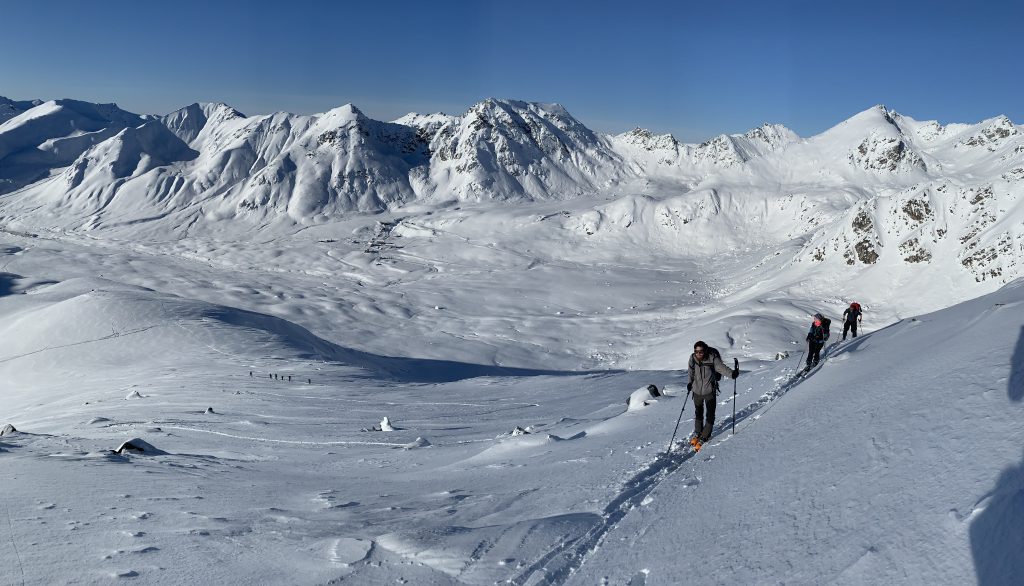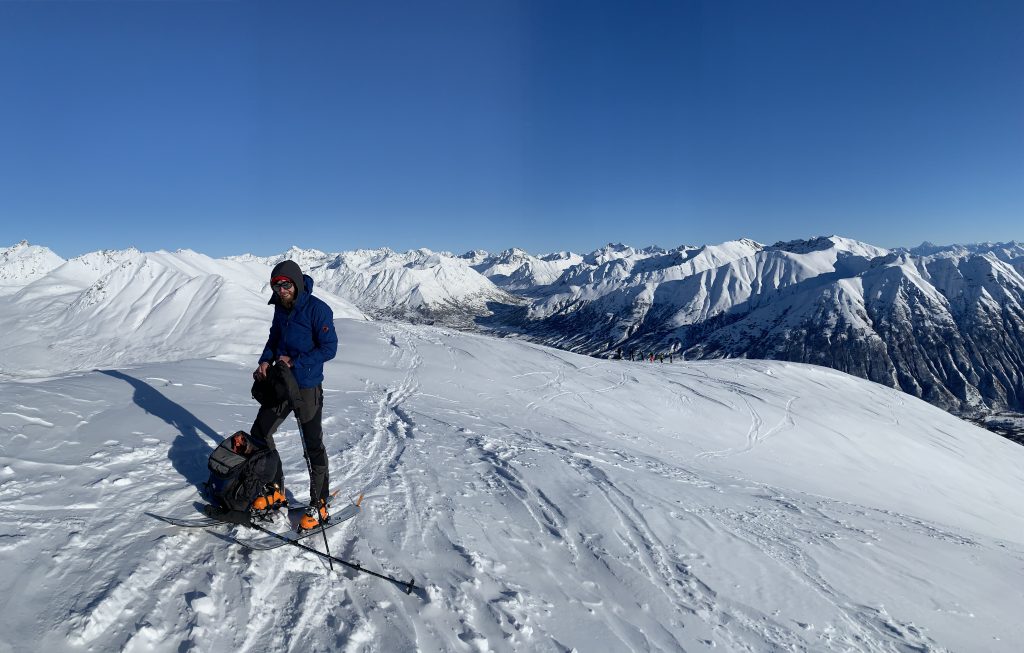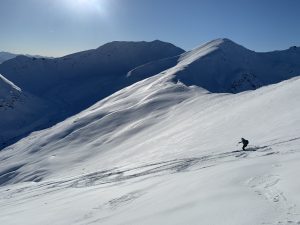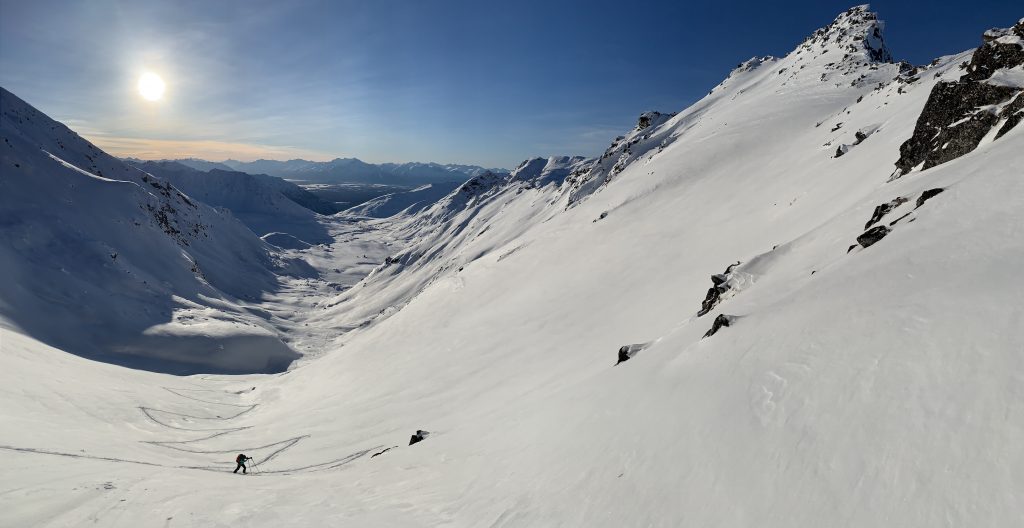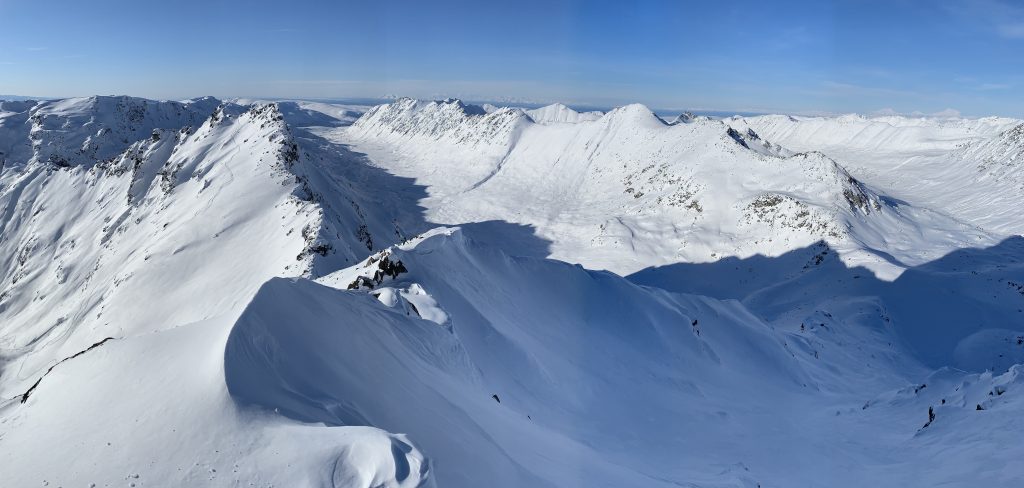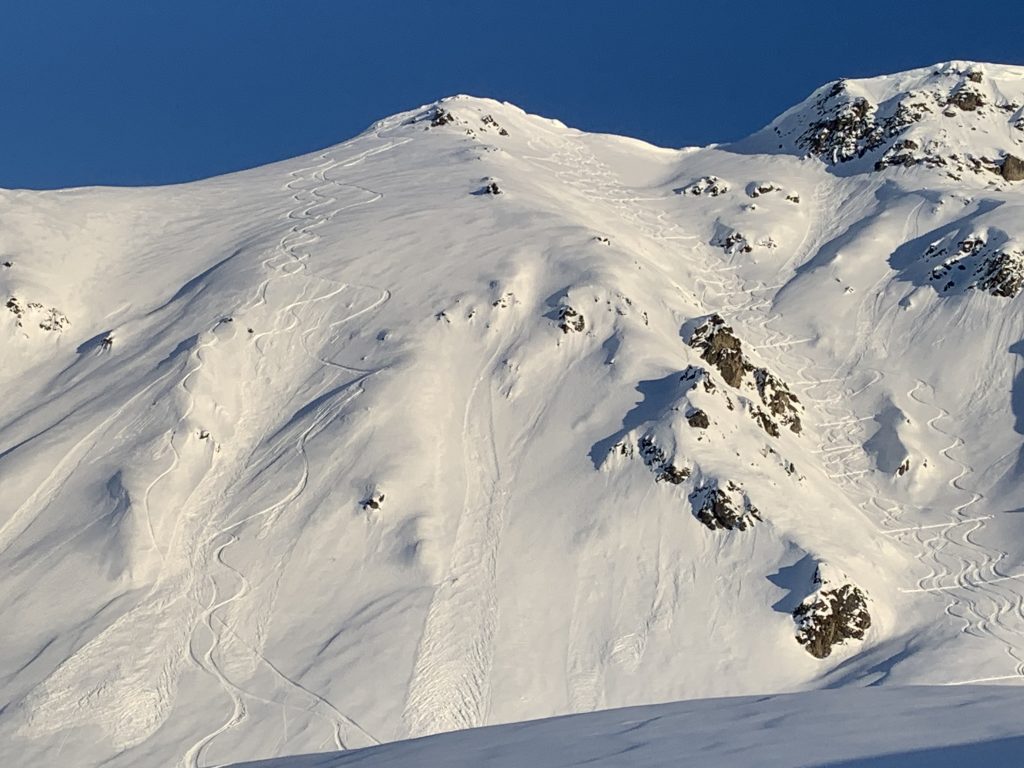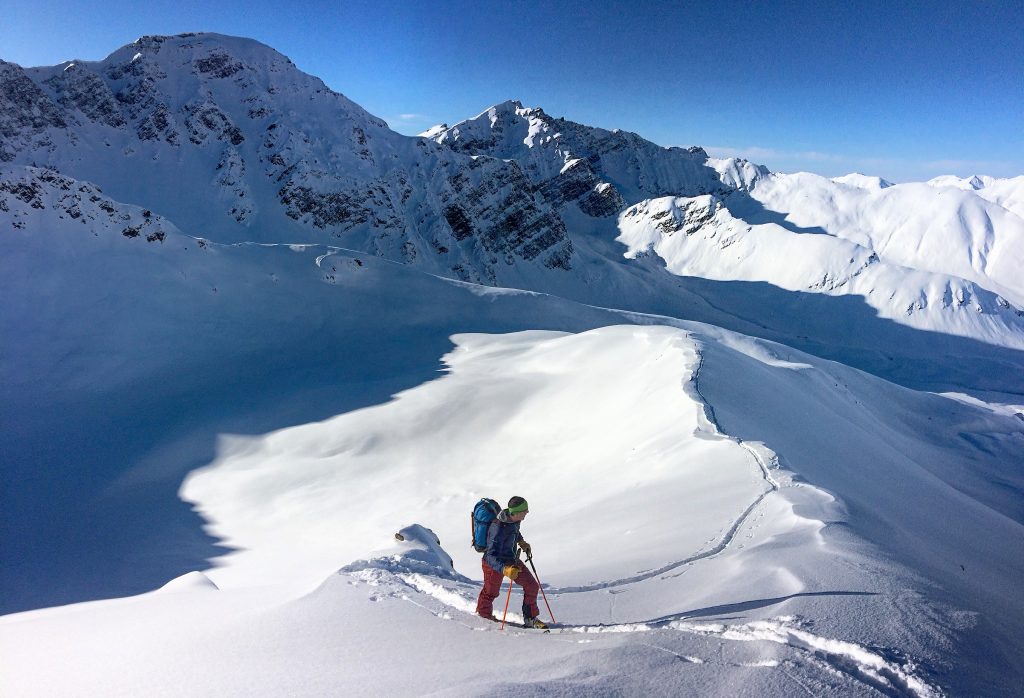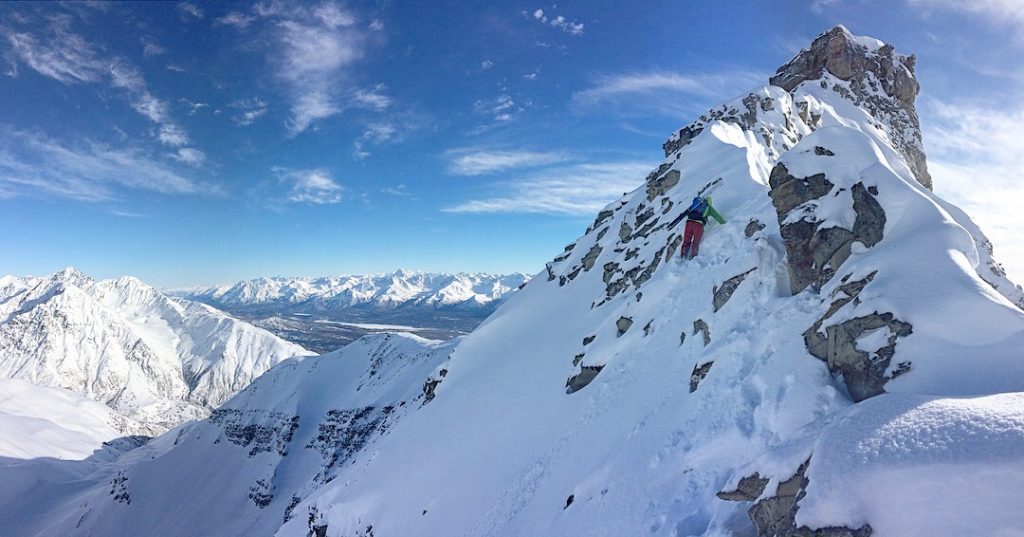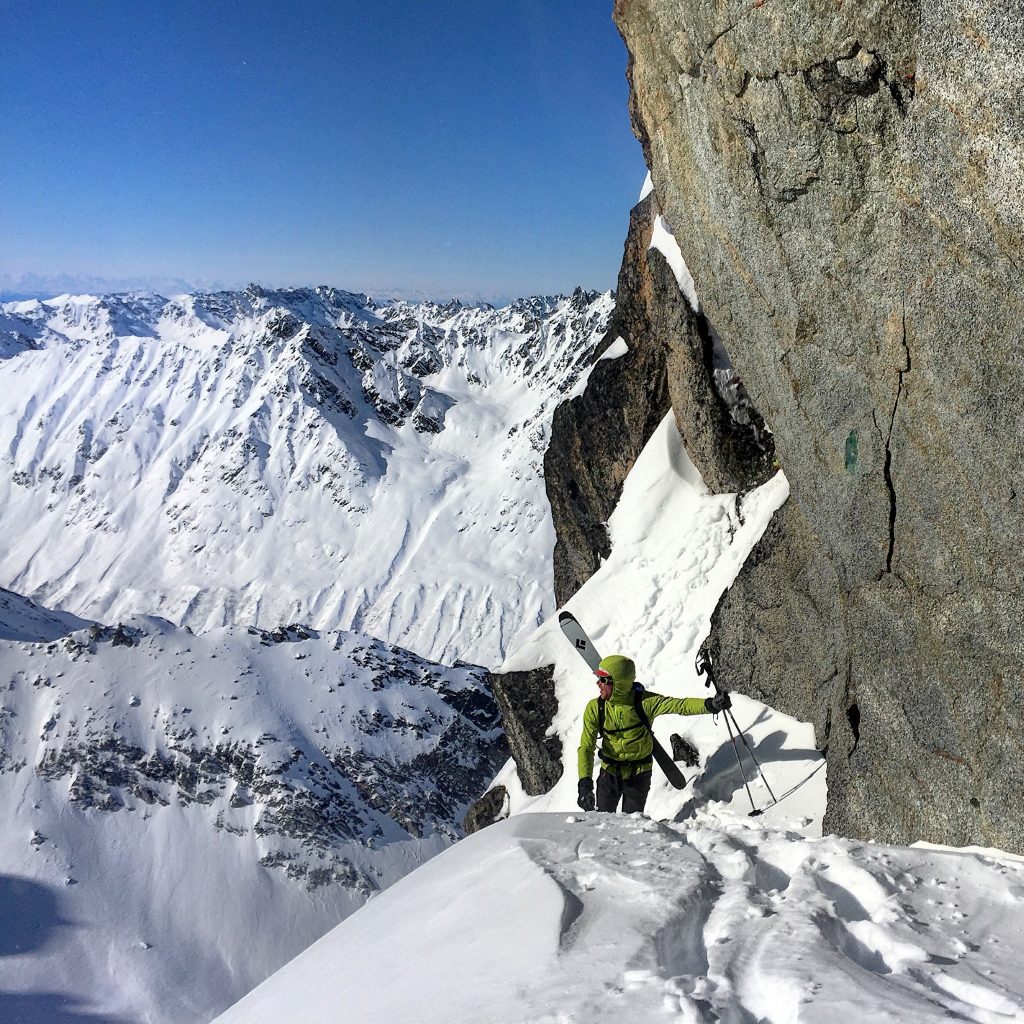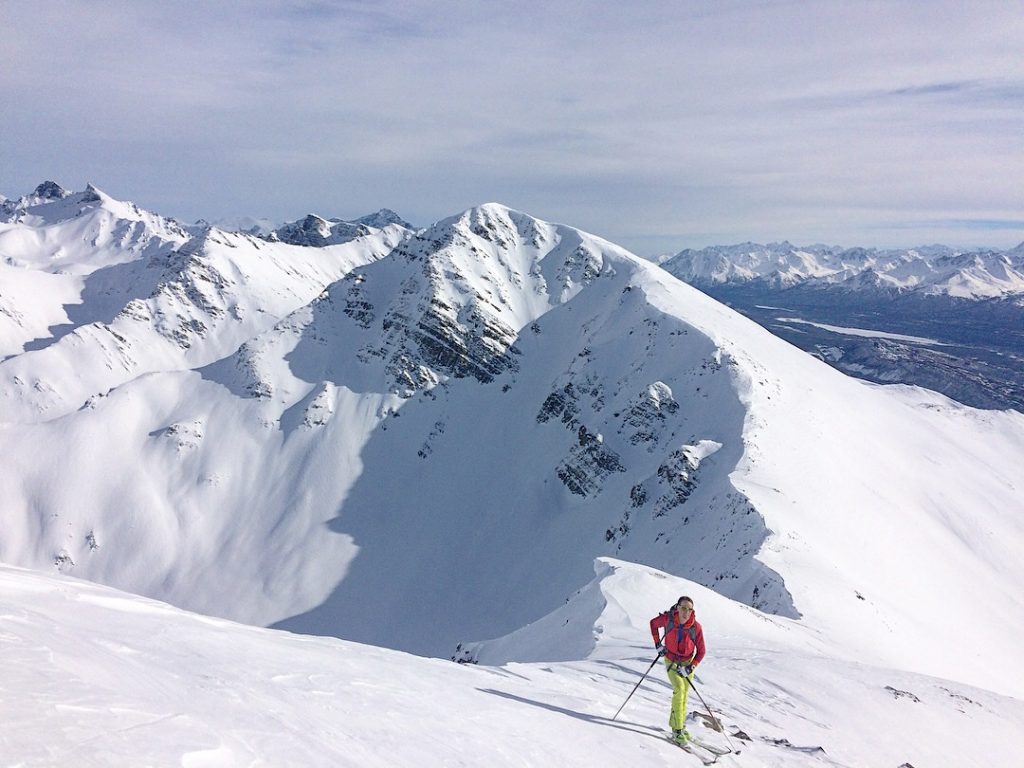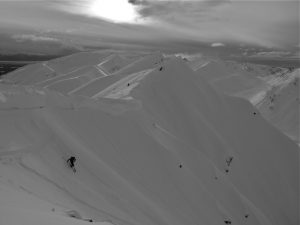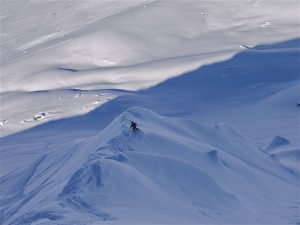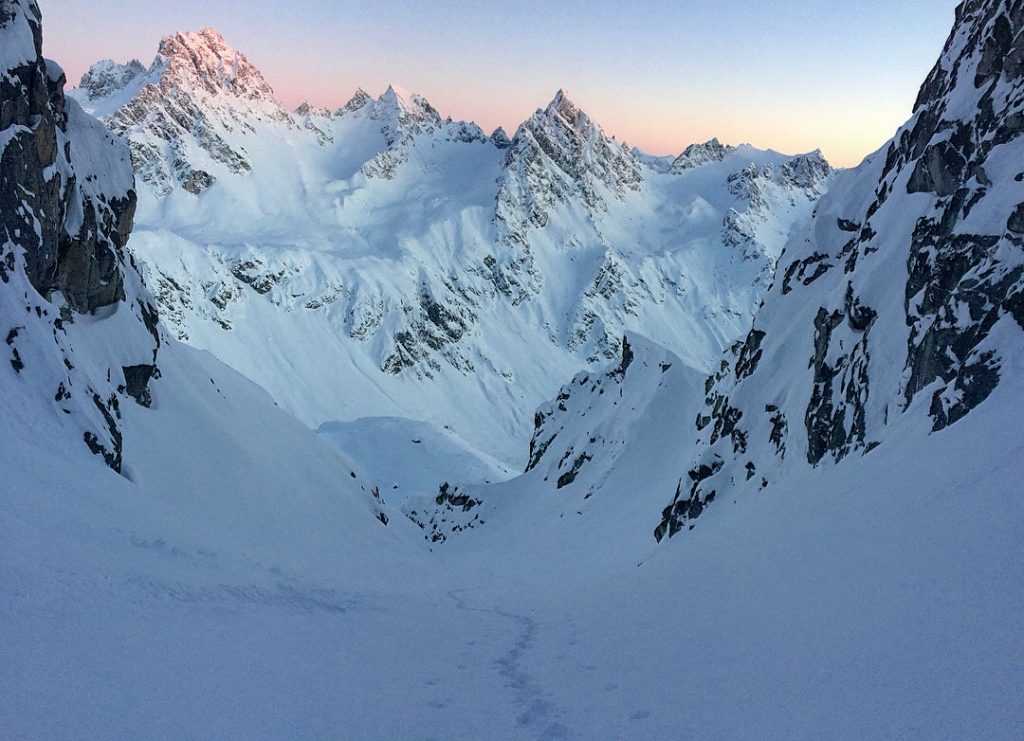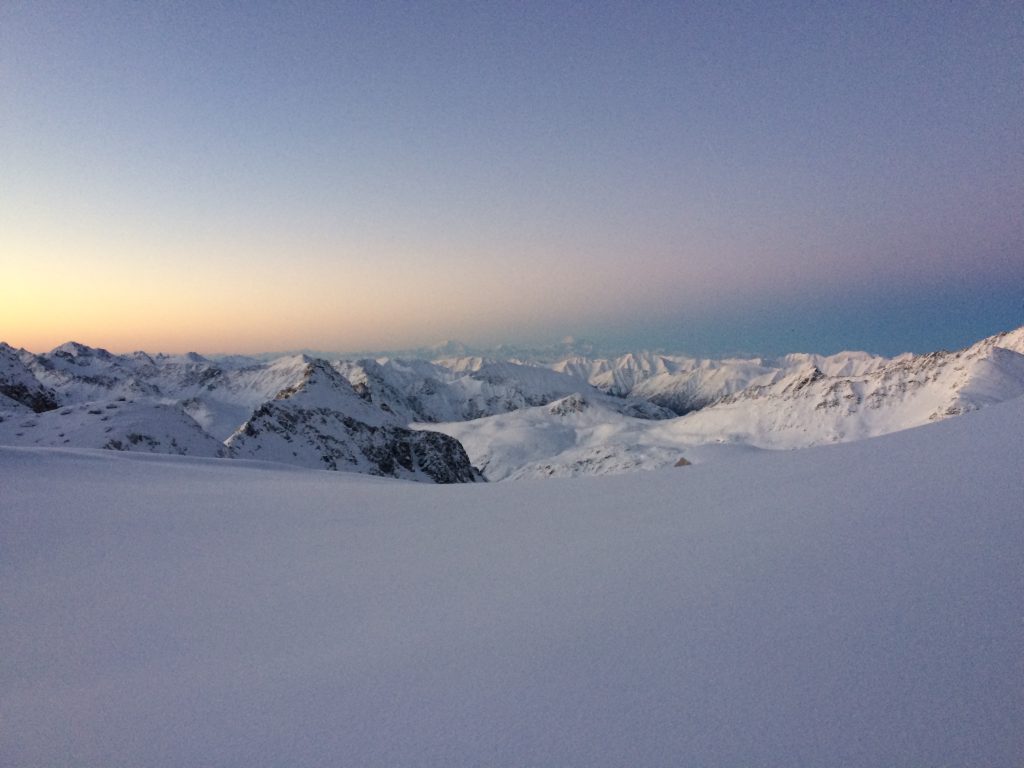Students in UAA’s “Skiing Alaska’s Backcountry” course enjoy an escape from the machine at Hatcher Pass. Students have been taking this course for years, with regular trips to Hatcher during the spring semester, without the nuisance of profiteering heli and snowcat operations which would destroy the traditional Alaskan backcountry experience at both locations were these photos were taken.
What do we value as Alaskans? What makes Alaska unique? What are Alaska’s greatest natural resources, especially in regard to our state’s future and the necessity of diversifying our economy – and in such a way as to build more ecologically sustainable means of revenue that can support our state and many generations of future Alaskans?
I know that I, along with countless other Alaskans, value our wild spaces and their rejuvenative and transformative power. Our wild spaces provide a respite from the pressures of modern industrial life, that many find burdensome. That burdensomeness in part being a result of our isolation from nature, living by the clock, and spending so much time indoors. It’s a new experience for our species, as we evolved in intimate contact with the natural world and for the vast majority of human existence spent most of our time “outdoors” – or, at least, when “indoors” in structures much less abstract from nature than the square-cornered and artificially constructed spaces of contemporary times. Our primordial wild spaces provide a peace of mind unlike anything else the modern world has to offer.
Many people live in and move to Alaska for its uniqueness. That uniqueness is the vastness of its wild spaces, and the opportunities the Greatland provides for modern humans to live closer to nature and experience landscapes un-molested by the industrial world. Do we want to lose that?
The Anchorage metro to Mat-Su valley area is the most densely populated region of Alaska, and is home to the majority of the state’s population. Despite the urban and semi-urban lifestyles of most people living in this region, we are blessed to have vast wild spaces as respite just minutes away. These are serene spaces where we can play and rejuvenate our being.
For an ever-growing number of people, Hatcher Pass is one such wild space – and it’s a very special one. It’s a wondrous (and fragile) alpine environment that’s relatively accessible by most of the state’s population. Its beauty, and the recreational opportunities it provides, are world-class. If it were to exist in any other area of the developed world, it would likely enjoy much greater environmental protections and commercial restrictions than it does here in Alaska – and that’s for a reason: in large part, to protect the wilderness experience it provides for future generations.
The Friendship & Dogsled Pass zones as seen from the Schroff-O’Neil area. The terrain seen in these photos are easily accessible by non-motorized means from the upper Hatcher Pass winter parking lot by a fit party, and is almost entirely within the proposed boundaries for profiteering commercial heli and snowcat operations by “Hatcher Pass Mountain Guides.”
That said, I write to express my opposition to the proposed commercial snowcat and heli ski operations in the Hatcher Pass area Talkeetna Mountains. This easily accessed mountainous recreation area has long been popular with non-motorized winter recreationists, namely nordic and backcountry skiers. Non-motorized (and very low-impact) backcountry use has perhaps the longest history of winter use of this area, and the preservation of that experience for future generations of Alaskans should be a priority. The area is a place of remarkable natural beauty, and is a recreational respite for countless Alaskans (the numbers of which grow every season).
It is already a busy place. Go to Hatcher Pass on a sunny, bluebird winter day and there are people everywhere. This is a recent development perhaps largely due to the growth of the Hatcher Pass Avalanche Center which has demystified the snowpack of the area, drawn attention to the area’s potential for backcountry recreation of all persuasions (skiing, snowboarding, snowmobiling, etc.), and attracted a lot more winter backcountry use by both non-motorized and motorized users. The area is already relatively high pressure, and the experience of non-commercial users would be greatly tarnished by allowing a profiteering commercial operation such as that proposed in LAS 32622.
Lots of tracks in late February of 2019, in what used to be an obscure zone at Hatcher Pass. Prior to the 2019 season I had never been in this valley with another party present. During the spring of 2019 this valley saw multiple parties on many days. The day this photo was taken there were over a dozen people in the area, with riders descending on top of one another (plenty of congestion without the addition of for-profit heli and snowcat operations).
A shot from the same zone from the prior season, when each time I visited the area I had to break trail…and could return days later to find it just as I’d left it with no additional traffic. Things are changing quick in Southcentral Alaska (i.e. crowds), and our rapidly growing outdoor community doesn’t need potentially high-impact, profiteering commercial operations further burdening the commons.
There is currently a lift-serviced ski area under development at Hatcher Pass, but it is a stationary venture in an isolated location. Allowing commercial motorized operations that are not stationary or isolated would greatly impact the Hatcher Pass experience for more traditional users groups (skiers, snowshoers, snowboarders, and snowmachiners). There are countless other worries associated with this commercial, for-profit, and potentially high-impact venture as proposed in LAS 32622.
It’s very worrisome that permitting the proposed activities of LAS 32622 would make Hatcher Pass like Thompson Pass, where relatively unregulated and “Wild West” commercial heli operations are extremely problematic for all other (non-commercial) user groups. However, unlike Thompson Pass, Hatcher Pass is not “in the middle of nowhere” and is popular with biggest population of winter backcountry enthusiasts in the state. Plus, Thompson Pass commercial operations are generally only an issue for a couple months of the year in the spring (due to the isolation and harsh weather of the venue). Whereas, the proposed commercial venture in Hatcher Pass seems like it could be a season- long (several month) operation. While official data isn’t available, Hatcher Pass is likely the most or second most popular winter recreation venue in the state (the other being Turnagain Pass). Such a venue can’t handle commercial operations on top of already high pressure non-commercial public land use.
Hatcher Pass is a sanctuary that provides unforgettable and life-enriching experiences; it should be protected as such.
In the Thompson Pass area of the Central Chugach Mountains, for-profit heli operations commit offenses against non-commercial public land users that would be unthinkable in areas like Turnagain Pass or (until now) Hatcher Pass. As soon as conditions permit after a storm, they begin by harvesting the most easily accessible powder for non-motorized users (the equivalent of Sunburst and Magnum on Turnagain Pass, or Marmot and Microdot at Hatcher Pass). After they’ve tracked up the lowest- hanging fruit, they begin harvesting slightly further out but still easily accessible powder non- commercial snowmachine-assisted riders would otherwise enjoy. It seems like only after all the low- hanging fruit is harvested, and if there’s an extended stretch of good weather, that they venture deeper into the mountains – to areas where it would be difficult for non-motorized users to access and at least somewhat involved for snowmachiners to access.
This is an absurd and unethical, profiteering practice on so many levels. I do get it from a business perspective, although an unethical and unscrupulous one: it’s maximizing profit (but with no social consciousness). It rips off heli-ski clients in that they’re skiing and riding what they could access on their own from the road via non-motorized means for free with a bit of fitness and avalanche education. It rips off the non-commercial public land user and local constituents because they can’t enjoy the snow before its molested by these for-profit operations. What’s perhaps most frustrating about this practice is that the heli provides practically unlimited access, so why steal the limited access available to non- commercial public land users? The answer is greed.
These for-profit ventures want to maximize profit, and seemingly lack social consciousness. These ventures often bring in employees from Outside that have no connection to the local communities. Thus, there’s no community-based repercussions for their unethical and unscrupulous behavior because they aren’t part of those communities. If the heli operators and their employees were at least based in the local communities, than they would likely behave more ethically due to community-based repercussions for frustrating local public land users and constituents. Instead, they harvest the low- hanging fruit, maximize profits, fill their bank accounts for a couple months with easy money, frustrate the local community and visiting public land users from other areas of Alaska, and then return to the Outside where they spend that money they unscrupulously extracted from Alaska.
Keep carbon-gluttonous, for-profit ventures out of our wild public spaces!
That’s the scene at Thompson Pass near Valdez. Do we want to open the door to that sort of profiteering at Hatcher Pass? Fortunately, due to federal land on the Kenai being more highly regulated, we don’t have that problem at Turnagain Pass (the other very popular winter recreation area that serves public land users from Alaska’s most populous region). Additionally, employees of Chugach Powder Guides (the heli-operator based in Girdwood that operates in the Western Chugach and Kenai Mountains) are locally based. Between the more highly regulated federal land use policies, and the guides being locally based and subject to community repercussions for unethical and unscrupulous behavior, Chugach Powder Guides is relatively responsible for a heli-operator. They don’t harvest low-hanging fruit (generally being denied access to it thanks to the fed’s more civilized land management policies) and the general public land user accessing the mountains via the road corridor from Girdwood south rarely sees or hears them.
Keep Hatcher Pass WILD and FREE! It’s taken a lot of time and energy to address motorized and non-motorized conflict in the area (with both of these users groups being non-commercial), and get these communities to co-exist peacefully. We don’t need to re-ignite conflict in one of Alaska’s most beloved winter recreation areas by allowing intrusive, profiteering commercial operations that would undoubtedly disrupt the hard-earned peace.
Even if DNR were to allow the commercial venture as proposed in LAS 32622, and attempt to regulate it in such a way as to preserve the experience of the more traditional public land users of the Hatcher Pass area, the nature of the terrain in this zone would make that nearly impossible; it’s too condensed. Helicopters and snowcats would undoubtedly be within sight and sound, and greatly degrade the experience of this wild space. Wild spaces such as Hatcher Pass are one of Alaska’s greatest natural resources moving forward into the future, both in terms of supporting the wellness of our state’s most populous region by offering world-class recreational opportunities and as a source of more sustainable revenue and economic diversification via low-impact recreational tourism.
But, that sustainable revenue and economic diversification should not be in the form of a potentially high-impact, for-profit, commercial venture such as that proposed in LAS 32622. And, if permitted, LAS 32622 would detract from the Hatcher Pass area’s potential to generate lower-impact revenue, sustainable economic diversification, and support local citizens’ wellness. I’ve already explained how it would detract from local citizens’ wellness in terms of how it would degrade the experience of more traditional, non-commercial snow-season public land users of the Hatcher Pass area. It would also detract from the area’s ability to provide a more sustainable and lower-impact source of revenue.
Why? Let’s start with an example of what a more sustainable, lower-impact source of revenue might be: non-motorized guiding. This sort of low-impact, unobtrusive, and relatively unnoticeable commercial venture would not detract from the traditional user group’s experience. It would also provide a means for that experience to be shared with less experienced public land users, who may be hesitant about getting out in the often avalanche-prone terrain of Hatcher Pass (and you don’t get the experience of learning how to travel through avalanche terrain from a guide via snowcat or heli because the snowcat or heli is doing the backcountry travel for you). A guided heli or snowcat experience is also much more expensive than a non-motorized guided experience, which is more accessible to a wider socioeconomic population base. Encouraging non-motorized guided experiences would provide opportunities for more people to enjoy Hatcher Pass, and with less impact than even small-scale motorized commercial operations. However, fewer people will want to pursue these lower-impact forms of recreation in the area if it’s trampled by motorized commercial operations with their noise pollution and powder thieving. This is the case at Thompson Pass, where many non-motorized guides have given up on the experience there due to the disruptiveness of commercial heli operations.
Rae Wallace chutes and spines “back in the day” (2012) when Hatcher Pass was a much less happening place, with a relatively intimidating snowpack (that had not yet been demystified by an avalanche center), and less crowds on a perfect powder and bluebird Saturday that there are now on a greybird weekday with questionable snow quality. You could ski the Rae Wallace Chutes days after a storm with less tracks than there are now hours after a storm.
Not only will the noise, tracks, and harvesting of easily accessible powder by a commercial motorized (especially heli) operation detract from the traditional user groups’ experience, but this sort of motorized commercial operation opens the door for all sorts of conflict. These conflicts exist in Thompson Pass. That is, heli operations dropping in on non-motorized and snowmachine-assisted backcountry riders and subjecting these public land users to potentially dangerous (if not deadly) situations in regard to avalanches and falls. Hatcher Pass is a much smaller and higher pressure recreation area, and this conflict would be exponentially worse.
Pertaining to the map with boundaries of the proposed motorized commercial operations on state land; blocks 3, 4, 5, 16, 17, 20, 28, 29, 32, and 33 are in high pressure snow-season recreation areas that receive intense non-commercial motorized and non-motorized use. The non-commercial public land use for recreational purposes in these areas has been established for decades. There is absolutely no justification for allowing motorized commercial operations in these zones; it would destroy the experience of the long-standing, non-commercial snow-season public land use in these areas. Conflict between non-commercial public land users and commercial operations in these areas would be certain, and dangerous. Does the State of Alaska want to be liable for the dangerous situations that may arise by disrupting the traditional use in these areas? If the DNR were to approve commercial motorized operations in these areas it would demonstrate gross negligence, incompetence, irresponsibility, and an utter neglect of local constituents, public land users, and traditional use.
Heading up Black Prospect Peak after a likely first descent off Schroff-O’Neil Peak (February 2019).
So, what is the commercial operation as proposed in LAS 32622 offering the general public land user and local constituents whose public land they’ll be profiting from? What are they offering the local community? What’s their plan for mitigating their environmental and social impact? Do they even have one? The People of the State of Alaska, especially the local constituents and public land users, deserve adequate answers to these questions.
At the least, the State of Alaska needs to extend the public comment period and hold public hearings to solicit feedback. This is too big of an issue for the largest population of winter backcountry enthusiasts in the state, who reside in the greater Anchorage and Mat-Su Valley areas and depend on the Hatcher Pass backcountry experience for their wellness, to slide under the radar – as it seems it might have, had it not been for the astute surveillance of those that care deeply about preserving the wild Hatcher Pass experience.
If you don’t support for-profit, high-impact, commercial operations profiteering off our public lands in the Hatcher Pass area Talkeetna Mountains, and destroying the backcountry snow experience this wondrous area has provided Alaskans for decades; contact Jay Rokos at jay.rokos@alaska.gov with your public comments by May 2, 2019. Further information can be found here.
Please take action to preserve the WILD and FREE Hatcher Pass experience for future generations!

